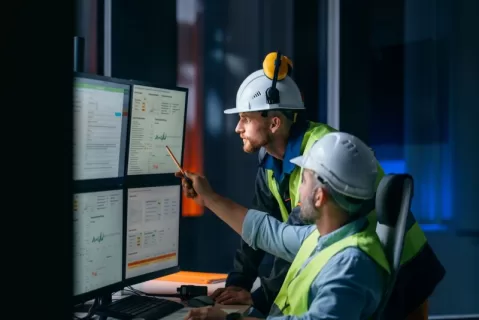The construction industry, long known for its reliance on manpower and traditional methods, is on the cusp of a transformative era. Innovative construction equipment, fueled by advancements in technology, is revolutionizing how we build. This is not merely about replacing hammers with high-tech gadgets; it’s a paradigm shift that promises to reshape the industry’s landscape.
From robotic bricklayers that tirelessly construct walls with unwavering precision to wearable technology that safeguards workers from potential hazards, the future of construction is being rewritten. This article discusses the key categories of innovative equipment and examines the challenges and considerations of adopting these technologies.
The Need for Innovation
The construction industry faces persistent challenges that hinder its progress and efficiency. Labor shortages, fueled by an aging workforce and a lack of new skilled workers entering the field, have become increasingly problematic. Safety concerns remain paramount, with accidents and injuries posing significant risks to workers and project timelines.
Furthermore, cost overruns, often caused by unforeseen delays, material price fluctuations, and inefficient processes, continue to plague the industry. Traditional construction methods, while tried and tested, are struggling to keep pace with the growing demands and complexities of modern projects. Manual labor-intensive processes are time-consuming and prone to errors, while outdated equipment lacks the precision and efficiency required for optimal results.
These limitations not only impede productivity but also contribute to escalating costs and safety hazards. In the face of these challenges, innovation offers transformative solutions that can reshape the industry. Companies such as Northwest Flow Technologies are in the forefront of this innovation providing valuable upgrades to construction equipment such as rotary positive displacement blowers.
Key Categories of Innovative Equipment
Innovative construction equipment encompasses a wide range of technologies aimed at addressing the industry’s pressing challenges and unlocking new levels of efficiency, safety, and sustainability. Here’s a deeper look into some key categories that are transforming the construction landscape.
Automation and Robotics
Automation and robotics are revolutionizing construction sites by automating repetitive, labor-intensive tasks. Robotic bricklayers, for instance, can lay bricks with remarkable speed and precision, significantly reducing the time and manpower required for masonry work.
Autonomous excavators equipped with GPS and sensors can perform excavation tasks with greater accuracy and consistency than traditional methods. Drones equipped with high-resolution cameras and LiDAR sensors are being used for surveying and mapping construction sites, providing detailed data for project planning and monitoring.
These technologies offer several benefits, including increased precision, reduced manual labor, and the ability to operate around the clock. By automating tasks that were once performed by humans, construction companies can reduce the risk of accidents and injuries, while also improving project timelines and reducing costs.
Wearable Technology
Wearable technology is empowering construction workers with real-time information and protection. Smart helmets equipped with sensors can detect hazards like falls, impacts, and dangerous gas levels, alerting workers and supervisors in real time. Exoskeletons, wearable devices that provide support and assistance to the wearer, are being used to reduce strain on workers’ bodies and prevent injuries caused by repetitive motions and heavy lifting.
The benefits of wearable technology are significant. Real-time worker safety monitoring can help prevent accidents and injuries, while the use of exoskeletons can reduce the risk of musculoskeletal disorders and fatigue. By enhancing worker safety and well-being, wearable technology contributes to a more productive and sustainable workforce.
Data and Analytics
Data and analytics are playing an increasingly crucial role in construction, enabling data-driven decision-making and optimizing project outcomes. Building Information Modeling (BIM), a digital representation of a building’s physical and functional characteristics, allows for better collaboration and coordination among stakeholders throughout the project lifecycle. Artificial intelligence (AI) is being used for project management, analyzing vast amounts of data to identify potential risks and optimize resource allocation.
The use of data and analytics in construction offers numerous advantages, including streamlined workflows, improved efficiency, and cost savings. By leveraging data insights, construction companies can make more informed decisions, identify and mitigate risks early on, and optimize project performance.
Sustainable Equipment
Sustainable construction equipment is gaining traction as industry seeks to reduce its environmental impact. Electric-powered machinery, such as excavators, loaders, and cranes, offer a cleaner alternative to traditional diesel-powered equipment, reducing emissions and noise pollution. Equipment made from recycled materials and designed for energy efficiency further contributes to sustainable construction practices.
The benefits of sustainable equipment are significant. Reduced emissions and lower environmental impact help construction companies comply with stricter environmental regulations and contribute to a greener future. Additionally, sustainable equipment can lead to cost savings through lower energy consumption and reduced maintenance requirements.
Challenges and Considerations
While the benefits of innovative construction equipment are undeniable, their adoption is not without challenges and considerations. These factors need to be carefully addressed to ensure successful implementation and maximize the potential of these technologies.
Cost of Adoption
The upfront cost of acquiring and implementing innovative construction equipment can be substantial. Robotic systems, drones, and wearable technology often require significant financial investment, posing a challenge for smaller construction firms with limited budgets. Additionally, the cost of software licenses, maintenance, and repairs can further add to the overall expenses.
However, it is crucial to consider the long-term return on investment (ROI) when evaluating the cost of adoption. While the initial investment may seem daunting, innovative equipment can lead to significant cost savings in the long run. Increased productivity, reduced labor costs, and minimized downtime due to accidents and errors can outweigh the initial expenses, making these technologies a worthwhile investment for many companies.
To mitigate the financial burden, construction firms can explore various financing options, such as leasing or renting equipment, or partnering with other companies to share the costs. Additionally, government incentives and grants aimed at promoting the adoption of innovative technologies can provide financial support to companies willing to embrace these advancements.
Training and Upskilling the Workforce
The successful adoption of innovative construction equipment hinges on the workforce’s ability to operate and maintain these technologies effectively. Training and upskilling programs are essential to ensure that workers possess the necessary skills and knowledge to utilize these tools safely and efficiently.
Investing in comprehensive training programs can empower workers to embrace new technologies and adapt to changing work environments. By providing hands-on experience and theoretical knowledge, training programs can equip workers with the confidence and competence to operate complex machinery, interpret data, and troubleshoot technical issues.
Furthermore, upskilling the workforce can lead to increased job satisfaction and career advancement opportunities for employees. By investing in their professional development, construction companies can foster a culture of innovation and attract and retain top talent.
Integration with Existing Systems
Integrating innovative equipment with existing systems and processes can be a complex undertaking. Compatibility issues, data integration challenges, and the need for standardized protocols can pose significant hurdles during implementation.
To overcome these challenges, construction companies need to carefully assess their existing infrastructure and identify potential bottlenecks. Collaborating with technology providers and system integrators can help ensure seamless integration and minimize disruptions to ongoing operations.
Adopting a phased approach to implementation can also facilitate smoother integration. By gradually introducing new technologies and allowing for adjustments and fine-tuning, companies can avoid overwhelming their systems and ensure a seamless transition.
Regulatory and Safety Standards
The rapid pace of technological advancements in the construction industry often outpaces the development of regulatory frameworks and safety standards. As new equipment and technologies emerge, it is crucial to establish clear guidelines and regulations to ensure their safe and responsible use.
Regulatory bodies and industry organizations play a vital role in developing and enforcing safety standards for innovative construction equipment. Collaboration between these stakeholders is essential to create a regulatory environment that fosters innovation while ensuring the safety and well-being of workers and the public.
Construction companies also have a responsibility to prioritize safety and adhere to established guidelines. By implementing rigorous safety protocols, conducting regular inspections, and providing ongoing training, companies can mitigate risks and create a safe working environment for their employees.
The Future of Construction Equipment
The future of construction equipment is brimming with exciting possibilities as emerging technologies continue to reshape the industry. These advancements promise to further enhance efficiency, safety, and sustainability on construction sites, paving the way for a new era of building.
Emerging Trends
Several emerging trends are poised to revolutionize construction equipment. 3D printing, also known as additive manufacturing, is gaining momentum in the construction sector. This technology allows for the creation of complex structures and components on-site, reducing material waste and enabling greater design flexibility.
For instance, augmented reality (AR) is a promising technology that overlays digital information onto the real world, providing workers with valuable insights and guidance during construction tasks. AR can be used for visualizing designs, identifying potential hazards, and providing step-by-step instructions for complex procedures.
Potential Impact on the Industry
The potential impact of these emerging trends on the construction industry is immense. 3D printing could revolutionize the way buildings are constructed, enabling faster and more cost-effective construction of complex structures. IoT connectivity could significantly improve equipment utilization and efficiency, reducing downtime and optimizing resource allocation. Augmented reality could enhance worker safety, improve productivity, and streamline construction processes.
These technologies can address some of the most pressing challenges facing the construction industry, such as labor shortages, safety concerns, and cost overruns. By automating tasks, improving communication and collaboration, and enhancing worker safety, emerging technologies can transform the construction landscape and create new opportunities for growth and innovation.
Conclusion
The integration of innovative construction equipment is not merely a trend but a necessity for the industry’s advancement. By embracing automation, wearable tech, data-driven insights, and sustainable practices, construction companies can unlock unprecedented levels of efficiency, safety, and environmental responsibility. The future of construction is undeniably bright, and it’s being built with the tools of innovation.


